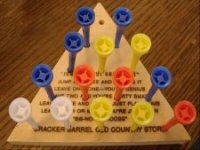Someone on AZB mentioned a way for beginners to learn straight pool. I don't remember who it was, but I call their idea "spread pool." (Someone correct me, please, if this idea has been around forever, and I'm only now just hearing about it.)
Spread out all 15 balls and take BIH. Start running balls. When you get to the last ball, call a pocket for it, but before shooting, spread out the other 14 balls again. With your next shot, you must sink what used to be the last ball in the pocket you called, even if there's a much better shot on the table now that the other 14 are out.
When I first heard about this game, I thought any idiot could run 100 balls if there were no clusters to manage. Hah! But, I've been working on this game fairly seriously, and yesterday I ran 66 balls...my new high run.
Seems to me the next step in learning straight pool could be to play the 19th century way. Rack all 15 balls and break hard. Start sinking balls. When you are down to the last ball, sink it. Then re-rack all 15 balls and break again. It doesn't matter if you fail to make a ball on that break; you get to keep shooting anyway--the only time you can continue a run without sinking a ball. I don't have a good name for this version but I think its original name was "Continuous Pool," which is why its modern variant is called "14.1 Continuous."
Anyway, it seems like a good way to learn straight pool is, first, reach some satisfying high run in "spread pool" by learning patterns, then reach that same run in "continuous pool" by learning cluster-busting, then reach that same run in modern straight pool.
Opinions?
Spread out all 15 balls and take BIH. Start running balls. When you get to the last ball, call a pocket for it, but before shooting, spread out the other 14 balls again. With your next shot, you must sink what used to be the last ball in the pocket you called, even if there's a much better shot on the table now that the other 14 are out.
When I first heard about this game, I thought any idiot could run 100 balls if there were no clusters to manage. Hah! But, I've been working on this game fairly seriously, and yesterday I ran 66 balls...my new high run.
Seems to me the next step in learning straight pool could be to play the 19th century way. Rack all 15 balls and break hard. Start sinking balls. When you are down to the last ball, sink it. Then re-rack all 15 balls and break again. It doesn't matter if you fail to make a ball on that break; you get to keep shooting anyway--the only time you can continue a run without sinking a ball. I don't have a good name for this version but I think its original name was "Continuous Pool," which is why its modern variant is called "14.1 Continuous."
Anyway, it seems like a good way to learn straight pool is, first, reach some satisfying high run in "spread pool" by learning patterns, then reach that same run in "continuous pool" by learning cluster-busting, then reach that same run in modern straight pool.
Opinions?
